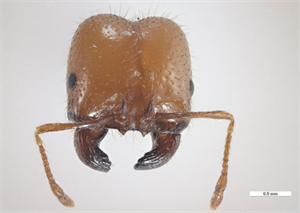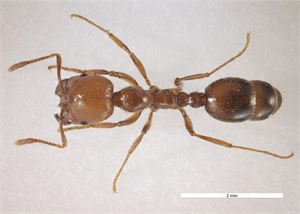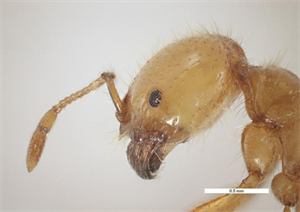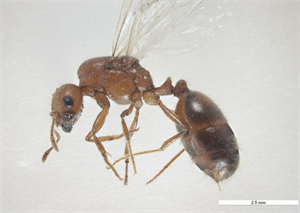- Worldwide distribution. Common in many Pacific island countries. Ground-nesting in sunny agricultural, forestry, grassland areas. Aggressive, painful sting. Among world's 100 worse invasive species.
- Nests slightly raised mounds, radiating below surface. Many hundreds per ha. Eats seeds, other insects, reptiles, amphibians, honeydew.
- Direct damage to seeds, plant parts, hoses, loss of biodiversity; indirectly by defending aphids, mealybugs, scales and whiteflies from natural enemies.
- Queens, males and three types of worker: minor, major and intermediate, that have changing tasks. Nests mostly with many queens, some single.
- Tramp ant. Spread by queens leaving the nest, nuptial flight then new site, or budding; spread with trade in horticultural.
- Biosecurity: requires risk assessments, regulations preventing introduction, protocols in case of breaches, and ability to make rapid response. Pacific Ant Prevention Plan available (IUCN/SSC Invasive Specialist Group).
- Cultural control: hot water at 47°C kills ants; over 49°C kills plants.
- Chemical control: use (i) stomach poisons (fipronil, Amdro®, borax), (ii) growth regulators (methoprene, pyriproxyfen), (iii) nerve poisons (bifenthrin, fipronil, imidacloprid). See (http://piat.org.nz/getting-rid-of-ants).
Pacific Pests, Pathogens and Weeds - Online edition
Pacific Pests, Pathogens, Weeds & Pesticides
Tropical fire ant (362)
Tropical fire ant, tropical red fire ant, ginger ant, red ant.
Solenopsis geminata
AUTHOR Grahame Jackson
Information from CABI (2017) Solenopsis geminata (tropical fire ant). Crop Protection Compendium. (https://www.cabi.org/cpc/datasheet/50568); and Pacific Invasive Ant Toolkit. (http://piat.org.nz/index.php?page=tropical-fire-ant); and Selonopsis geminata. AntWiki. (http://www.antwiki.org/wiki/Solenopsis_geminata); and AntWeb. (https://www.antweb.org/description.do?genus=solenopsis&species=geminata&rank=species); and from Solenopsis geminata (2018) Global Invasive Species Database.(http://www.iucngisd.org/gisd/speciesname/Solenopsis+geminata). Photo 1 Simon Hinkley & Ken Walker (2001) Tropical fire ant (Solenopsis geminata). Museum of Victoria. PaDIL - (http://www.padil.gov.au). Photos 2-5 Tracy Smith (2005) Tropical fire ant (Solenopsis geminata). Department of Agriculture Western Australia. PaDIL - (http://www.padil.gov.au).
Produced with support from the Australian Centre for International Agricultural Research under project HORT/2016/185: Responding to emerging pest and disease threats to horticulture in the Pacific islandsction, implemented by the University of Queensland and the Secretariat of the Pacific Community.








